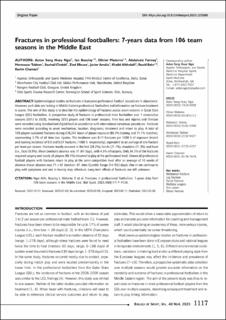Fractures in professional footballers: 7-years data from 106 team seasons in the Middle East
Ngai, Aston Seng Huey; Beasley, Ian; Materne, Olivier; Farooq, Abdulaziz; Tabben, Montassar; Chebbi, Souhail; Ellouze, Zied; Arnáiz, Javier; Alkhelaifi, Khalid; Bahr, Roald; Chamari, Karim
Peer reviewed, Journal article
Published version
Permanent lenke
https://hdl.handle.net/11250/3122732Utgivelsesdato
2023Metadata
Vis full innførselSamlinger
- Artikler / Articles [2119]
- Publikasjoner fra Cristin [1107]
Sammendrag
Epidemiological studies on fractures in European professional football (soccer) are in abundance. However, such data are lacking in Middle Eastern professional footballers and information on fracture treatment is scarce. The aim of this study is to describe the epidemiology of fractures across seven seasons in Qatar Stars League (QSL) footballers. A prospective study of fractures in professional male footballers over 7 consecutive seasons (2013 to 2020), involving 3255 players and 106 team’ seasons. Time loss and injuries and illnesses were recorded using standardised digital tools in accordance with international consensus procedures. Fractures were recorded according to onset mechanism, location, diagnoses, treatment and return to play. A total of 108 players sustained fractures during 638,247 hours of player exposure (88.9% training and 11.1% matches), representing 2.7% of all time-loss injuries. The incidence was 0.17 fractures per 1000 h of exposure (match and training incidence of 0.9 and 0.07 fractures / 1000 h, respectively), equivalent to an average of one fracture per team per season. Fractures mostly occurred in the feet (28.2%), hands (21.1%), shoulders (11.3%) and head (i.e., face) (9.9%). Mean (median) absence was 71 (47 days), with 4.6% refractures. Only 34.3% of the fractures required surgery and nearly all players (98.1%) returned to play at the professional level. Almost all professional football players with fractures return to play at the same competitive level after an average of 10 weeks of absence (mean absence was 71±81 (median: 47, Inter Quartile Range [14–93]) days). One in ten continue to play with symptoms and one in twenty may refracture. Long-term effects of fractures are still unknown.
Beskrivelse
This is an Open Access article distributed under the terms of Attribution-NonCommercial-NoDerivatives 4.0 International (CC BY-NC-ND 4.0) http://creativecommons.org/licenses/by-nc-nd/4.0), allowing third parties to copy and redistribute the material in any medium or format, provided that the article is properly cited, the use is non-commercial, and no modifications or adaptations are made.
Tidsskrift
Biology of SportOpphavsrett
© 2023 Institute of Sport – National Research InstituteBeslektede innførsler
Viser innførsler beslektet ved tittel, forfatter og emneord.
-
Fast track hip fracture care and mortality – an observational study of 2230 patients
Pollmann, Christian Thomas; Røtterud, Jan Harald; Gjertsen, Jan-Erik; Dahl, Fredrik Andreas; Lenvik, Olav; Årøen, Asbjørn (Peer reviewed; Journal article, 2019)Background: Hip fracture patients are frail and have a high mortality. We investigated whether the introduction of fast track care reduced the 30-day mortality after hip fractures. Methods: Fast track hip fracture care was ... -
Efficacy of vitamin C supplementation on collagen synthesis and oxidative stress after musculoskeletal injuries: A systematic review
DePhillipo, Nicholas; Aman, Zachary S.; Kennedy, Mitchell I.; Begley, J.P.; Moatshe, Gilbert; LaPrade, Robert F. (Journal article; Peer reviewed, 2018)Background: Recent investigations on the biochemical pathways after a musculoskeletal injury have suggested that vitamin C (ascorbic acid) may be a viable supplement to enhance collagen synthesis and soft tissue healing. ... -
Morphologic Variants of Posterolateral Tibial Plateau Impaction Fractures in the Setting of Primary Anterior Cruciate Ligament Tear
Bernholt, David; DePhillipo, Nicholas; Grantham, W. Jeffrey; Crawford, Matthew D.; Aman, Zachary S.; Kennedy, Mitchell I.; LaPrade, Robert F. (Peer reviewed; Journal article, 2020)Background: Impaction fractures of the posterolateral tibial plateau commonly occur in the setting of anterior cruciate ligament (ACL) tears, with considerable variability found in fracture size and morphologic features. ...
